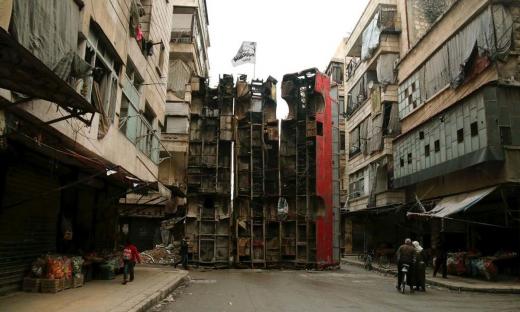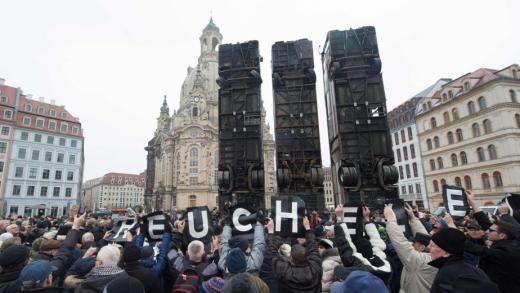Standing Tall Against War
Standing Tall Against War

Three buses are towering vertically into today's bright blue sky over the 18th of March Square in the historical center of Berlin. Even from afar, you can already see "Monument“, the disputed installation by the 32-year-old German-Syrian artist Manaf Halbouni, through the pillars of the Brandenburg Gate.
From November 11 to 26, "Monument" will be part of the 3rd Berliner Herbstsalon. In Dresden, where the installation was placed in front of the city's emblem Frauenkirche at the beginning of the year, the reactions from the public had been controversial. With its creator Manaf Halbouni we talked about the artwork, its impactful presence in physical and virtual public space, and the anti-war symbolism it bears in the peaceful city of Berlin today.
Vehicles and transportation are often part of your work.
Yes, vehicles are an important aspect. In my childhood it was like this: once you had a driver's licence and you could buy a car, it meant you were free. You could do whatever and go wherever you wanted. It is a small private symbol of freedom.
The public transport is also full of emotions. The whole day people are traveling from here to there. Each vehicle contains stories about people.
For your installation „Monument“ you used three German city buses and arranged them vertically in public space. Why did you name this sculpture „Monument“?
It is a monument against something – against war. When I saw the picture from Aleppo* for the first time, I thought to myself – this is a great sculpture. Then I started recognizing many different things in this picture, such as open stores, people trying to walk to work, kids playing, and I kept researching and seeing more pictures of a peaceful utopia without war. On one side of the buses you have people trying to continue their daily routines, and on the other side it's ruins, everything is destroyed. It was crazy to see what mankind can do, and what our brains do – we just pretend that life is continuing. They are dying on the other side, but we have to continue.

Upended buses barricade a street in Aleppo. The vehicles serve as protection against snipers loyal to Syria's President Bashar al-Assad, in the rebel-controlled Bustan al-Qasr neighbourhood.
Image © Ammar Abdullah / Reuters
How did you continue with the creative process after seeing the photograph of the barricade in Aleppo?
It started as a play. I saw this picture of buses in the newspapers and at first thought about Mad Max. Then I cut out this image of the buses in Photoshop and thought it would be nice to put it in an open space, maybe in front of Frauenkirche. Then I made this picture and posted it on Instagram as my new work in front of the church. A lot of people thought that it was really there. After that I tried it with other places: Berlin, Moscow, London, New York. After a few months of playing with these images, I thought it would be a pity if it stayed in this phase. Then I asked around if I could do it in real space. I started doing the research about buses and constructions, and looking for people who could support me.
How did you decide what you leave on the buses and what you take off?
From the outside I didn't take anything away. I wanted three buses and I wanted to leave them as original as possible; just to show that these buses used to transport people around. Those are normal buses you can see on the street.
The advertisements ("Sparkasse“) and the sticker saying "Schwarzfahren ist unfair“ (fare dodging is unfair) on the windows of the buses seem to add a layer of irony.
Sure, it gives the whole work a different taste. And that's the point. I don't want to transport the war situation from Aleppo to here because we are not living in war. The buses are also not attached to each other, there are gaps between them. They are standing as a sculpture, not as a barricade. We don't need them as a barricade; it's enough to put them there as a sculpture, which reminds us that war is terrible.

Manaf Halbouni's "Monument“ at the Brandenburger Tor
In Dresden, "Monument“ has provoked some extreme reactions, namely from the members of the far-right groups. In comparison, what was the reception of your work at the Brandenburger Tor like? Is there any difference in the discourse that is being produced around your work in Berlin at the moment?
It is the complete opposite. The opening here was great, lots of people, everyone was smiling and complimenting the work, saying that we need something like this just to remember how peaceful we are living. In Dresden half of the people were in favour of it, and the other half was just screaming – „put it down!“ The only bad reactions I got in Berlin were on the internet actually.
I did have a small talk with two people from Köpenick, who started saying to me things like – „what is this shit?“ And when I explained them the work, they were happy and made selfies with me in front of the buses, and said – „yeah, it's a good work!“ So, it's also important to be present, talk to the people, and tell them the story.
When we went to see "Monument” in Dresden earlier this year, we especially kept the flowers in mind, the letters that were left behind on the buses by the visitors, the condolences they expressed. In the media, the negative reactions were more present than the positive ones. Which reactions are more important for your artwork?
All of the reactions are important, the negatives as well as the positives. They stand as a mirror of our society.
How do all these reactions affect the work itself?
The buses themselves are not the artwork anymore. The art is what is happening around it. It is the reactions and the discussions between people. For me, the work is totally successful because I achieved what I wanted. I wanted people to start talking to each other, and it happened. In Dresden it was especially important because February 13th [editor's note: remembrance of the greatest air raid of Dresden city in World War II, which is used for propaganda by the nationalists in Dresden since 1990] is a very bad day. This year there were all these people in the city talking about art, what is art for and what is art allowed to do, and they didn't talk about the bombing. With my artwork I brought a break into this day and shifted focus on a different topic.
Do you in fact owe your fame to the screaming Pegida crowd in Dresden? Did they make your work known?
I thought many times about sending a letter to the chief of Pegida, Lutz Bachmann, to tell him: „Thank you!“
Isn't that ironic?
Yes, maybe. Youy may compare it to Batman and Joker. Joker was created by accident. Just that Lutz Bachmann definitely is not Batman, because that would mean he and Pegida would be the good people.

Pegida members protesting at the opening of "Monument" in Dresden. Image © Sebastian Kahnert / AFP
The concept of "Monument“ also involves a certain place and time. What does it stand for here in Berlin in November 2017?
The 9th of November is the day when Germany was reunited. In Berlin the work is getting this aspect of reunion and it's opening a discussion. We are living in really shitty times at the moment. We need to talk to each other more than ever to find solutions and compromises.
What are the main issues you're trying to problematize with your work and get people to discuss?
This rising of the far right at the moment. When you think about it, you actually feel fear. They are trying to censorship art; especially "Monument" is a good example for that. They started telling artists what is allowed to do and what not, what they can say or show. Once politics starts to censorship art, that means there is no democracy anymore. I would really be careful with freedom of art. Once this collapses, everything else will follow.
How do you feel about giving political statements on the war in Syria?
I don't talk about politics because I cannot have an objective opinion about the war in Syria. There are a lot of people fighting in Syria and each one is fighting for a different reason, but in the end it is all about the money. Syria is actually a money machine at the moment.
By putting up "Monument", you have also put yourself in a vulnerable and potentially dangerous position. How do you personally handle aggressive and hateful reactions? How do you protect yourself from negativity that is aimed at you?
I don't protect myself from stuff like this, I deal with it. I did an investigation about this interaction. People actually just opened their minds and they were very innocent in the way they shared their opinions. On the wall here [editor's note: in the foyer of the Maxim Gorki Theater] you can see a selection of 50 best emails out of 450 I received. What I got via email was mostly negative, but there were also a lot of positive ones.
Aside from participating at the Berliner Herbstsalon, what are you currently working on?
Freedom of travel is a topic I work with. I am trying to work with an airplane. We Europeans are very priviledged, we can easily go to different places. For us, living in the middle of Europe, it is totally normal to take an airplane to go from Berlin to Brussels. I just take my passport with me and I can go wherever I want. But there are people who, in their whole life, never got to come near an airport, or see a plane. A lot of people do not recognize how crazy this is.
If you think of the whole world, what would be the next best place for "Monument” to stand?
I would actually like to make a tour with the buses to a lot of cities which have been destroyed and rebuilt. As an opposite to Dresden, I would find Coventry in England very interesting. Dresden has been bombed by the British and Coventry has been totally destroyed by the Germans. I would be very happy if we could take the buses to the UK.
Maybe one day in the future Aleppo will be rebuilt and we could take the buses over there.
* * * * *
Manaf Halbouni's "Monument" is on view at the 18th of March Square in Berlin until November 26, 2017.
3. Berliner Herbstsalon
November 11 - 26, 2017
More info